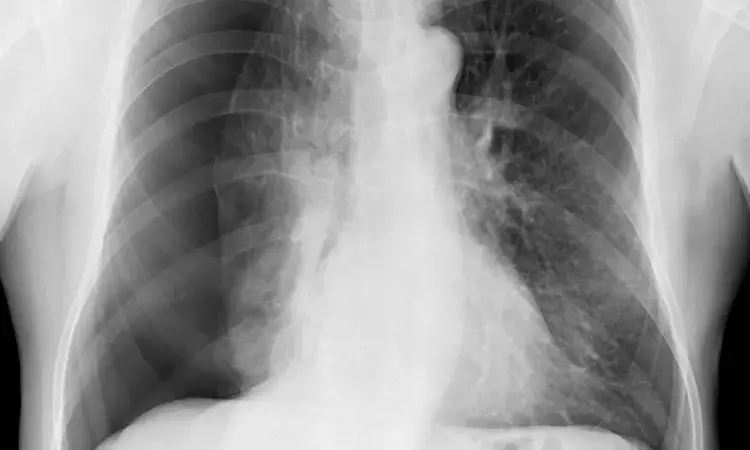- Home
- Medical news & Guidelines
- Anesthesiology
- Cardiology and CTVS
- Critical Care
- Dentistry
- Dermatology
- Diabetes and Endocrinology
- ENT
- Gastroenterology
- Medicine
- Nephrology
- Neurology
- Obstretics-Gynaecology
- Oncology
- Ophthalmology
- Orthopaedics
- Pediatrics-Neonatology
- Psychiatry
- Pulmonology
- Radiology
- Surgery
- Urology
- Laboratory Medicine
- Diet
- Nursing
- Paramedical
- Physiotherapy
- Health news
- Fact Check
- Bone Health Fact Check
- Brain Health Fact Check
- Cancer Related Fact Check
- Child Care Fact Check
- Dental and oral health fact check
- Diabetes and metabolic health fact check
- Diet and Nutrition Fact Check
- Eye and ENT Care Fact Check
- Fitness fact check
- Gut health fact check
- Heart health fact check
- Kidney health fact check
- Medical education fact check
- Men's health fact check
- Respiratory fact check
- Skin and hair care fact check
- Vaccine and Immunization fact check
- Women's health fact check
- AYUSH
- State News
- Andaman and Nicobar Islands
- Andhra Pradesh
- Arunachal Pradesh
- Assam
- Bihar
- Chandigarh
- Chattisgarh
- Dadra and Nagar Haveli
- Daman and Diu
- Delhi
- Goa
- Gujarat
- Haryana
- Himachal Pradesh
- Jammu & Kashmir
- Jharkhand
- Karnataka
- Kerala
- Ladakh
- Lakshadweep
- Madhya Pradesh
- Maharashtra
- Manipur
- Meghalaya
- Mizoram
- Nagaland
- Odisha
- Puducherry
- Punjab
- Rajasthan
- Sikkim
- Tamil Nadu
- Telangana
- Tripura
- Uttar Pradesh
- Uttrakhand
- West Bengal
- Medical Education
- Industry
Intraoperative partial spray of 50% glucose effectively prevents recurrence and complications in pneumothorax

Pneumothorax patients require surgical intervention, but recurrences are common postoperatively. Thoracic surgeons experimented with techniques like pleural abrasion, chemical pleurodesis, staple line coverage with absorbable sheets, and bullectomy to decrease these recurrences. Recently, the effectiveness of using intraoperative glucose intrapleural spray (GIS) containing 50 ml of 50% glucose solution in addition to bullectomy has been reported. However, information on the effects and adverse events of GIS is limited.
A study published in the Journal of Cardiothoracic Surgery concluded that intraoperative glucose intrapleural spray is safe and effective in preventing recurrences and postoperative complications.
This study assessed the efficacy and safety of GIS in preventing recurrence of pneumothorax. Researchers analyzed 74 cases of bullectomy, including those with/without GIS, at Okazaki City Hospital (2018 to 2021). Among these, 50 underwent GIS treatment, while 24 were treated conservatively.
Key findings from the study are:
- The GIS group comprised 46 males and only four females, while the C group had 23 males and a single female. The respective mean ages of the groups were 38.5 ± 5.7 years and 30.5 ± 6.7 years.
· The GIS group exhibited a mean increase in blood glucose of 23.8 mg/dL postoperatively.
· Two cases in the GIS group (4.0%) and two in the C group (8.3%) had postoperative infections.
· In the GIS group and the C group, the NRS scores of the patients three hours postoperatively were 4.0 and 3.1, respectively.
· No prolonged postoperative drainage period was observed by GIS (1.2 days and 1.4 days in the GIS and C groups, respectively).
· two patients in the C group had postoperative recurrence.
· In the GIS and C groups, postoperative total drainage volumes were 341.8 ± 25.2 ml and 74.2 ± 25.5 ml, respectively, significantly increasing drainage volume.
· None of them presented dehydration-related symptoms.
The safety and efficacy of using intraoperative glucose intrapleural spray have been established in this study to prevent recurrences and postoperative complications.
It is especially important to inform and educate nail technicians about the risks of ACD and the preventive measures that can be taken to reduce the likelihood of its occurrence.
Reference:
Kiriyama, Ryota, et al. "Efficacy and Safety of Intraoperative Partial Spray of 50% Glucose for Patients With Spontaneous Pneumothorax." Journal of Cardiothoracic Surgery, vol. 19, no. 1, 2024, p. 14.
BDS, MDS in Periodontics and Implantology
Dr. Aditi Yadav is a BDS, MDS in Periodontics and Implantology. She has a clinical experience of 5 years as a laser dental surgeon. She also has a Diploma in clinical research and pharmacovigilance and is a Certified data scientist. She is currently working as a content developer in e-health services. Dr. Yadav has a keen interest in Medical Journalism and is actively involved in Medical Research writing.
Dr Kamal Kant Kohli-MBBS, DTCD- a chest specialist with more than 30 years of practice and a flair for writing clinical articles, Dr Kamal Kant Kohli joined Medical Dialogues as a Chief Editor of Medical News. Besides writing articles, as an editor, he proofreads and verifies all the medical content published on Medical Dialogues including those coming from journals, studies,medical conferences,guidelines etc. Email: drkohli@medicaldialogues.in. Contact no. 011-43720751


